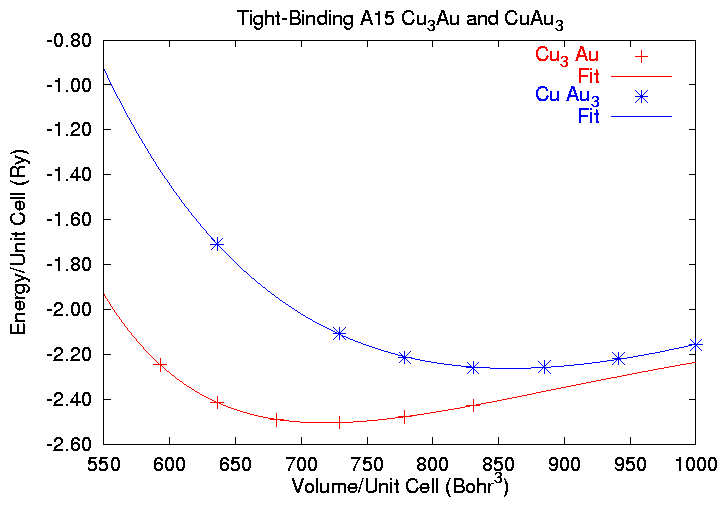
Last Modified 17 December 1999
On the previous page we showed how to set up the Slater-Koster INput (SKIN) file to determine the energy of the fictional A15 structure of Cu3Au as a function of volume. If you've followed all of the steps there, your working directory should look something like this:
$ ls -l total 96 -rw-r--r-- 2 mehl usr 6855 May 26 10:23 SKIN -rw-r--r-- 2 mehl usr 23228 May 26 10:06 cuau_par -rw-r--r-- 2 mehl usr 6474 May 26 10:06 sc.r06 -rw-r--r-- 6 mehl bind 10003 Jun 10 1996 spcgrp.a15
Running the static program using the SKIN file will produce some standard output, with more information in the SKOUT file. This particular run was done using the serial version of the program, and the results will look slightly different if you use the scalar version. In both cases the SKENG file looks like this:
Cu_3 Au 8.40 592.704000 .370933701 -2.247047067 .005054657 Cu_3 Au 8.60 636.056000 .348652093 -2.414179678 .002684015 Cu_3 Au 8.80 681.472000 .322882691 -2.491617646 .000870585 Cu_3 Au 9.00 729.000000 .299838638 -2.504613297 -.000206568 Cu_3 Au 9.20 778.688000 .281103881 -2.478340230 -.000785374 Cu_3 Au 9.40 830.584000 .263502094 -2.428505713 -.001100197 Cu Au_3 8.60 636.056000 .345302627 -1.709413631 .004803927 Cu Au_3 9.00 729.000000 .262682468 -2.106947524 .002929252 Cu Au_3 9.20 778.688000 .235768362 -2.214423203 .001459439 Cu Au_3 9.40 830.584000 .216380798 -2.259681857 .000356632 Cu Au_3 9.60 884.736000 .202132055 -2.257019274 -.000398672 Cu Au_3 9.80 941.192000 .190824986 -2.219453010 -.000892137 Cu Au_3 10.00 1000.000000 .181135331 -2.157111361 -.001200399
Each line represents one structure. The first three columns are from the 20 character label field of the SKIN file, which in this case represents the chemical composition and the cubic lattice constant. The next column is the Volume (in Bohr3), followed by the Fermi energy in Rydbergs, and the total energy in Rydbergs, and the pressure in Ry/Bohr3.
Finally, using the gnuplot scripta15fit.gnu which includes a fit the the third-order Birch equation, we can plot the behavior of the energy:

and get the Birch fit parameters:
$ gnuplot a15fit.gnu [Output of fitting routine deleted] Results of 3rd order Birch fit: Cu_3 Au: E_0 = -2.50584598421686 Ry V_0 = 718.291957470895 Bohr**3 a_0 = 8.95571644616303 Bohr B_0 = 200.529795246107 GPa B_0'= 7.7777506239406 Cu Au_3: E_0 = -2.26308558306084 Ry V_0 = 859.008419028051 Bohr**3 a_0 = 9.5060291147829 Bohr B_0 = 175.378374357495 GPa B_0'= 3.79985207145858
You can get information about the Birch fitting procedure from the gnuplot fit log. Note that these tricks only work if you have a current 3.6 Beta version of GNUPLOT, and you included the GD GIF library when you built the executable.
From the output, we find that Cu3Au has
Similarly, for CuAu3,
Using these parameters, you can check out the structural behavior of the Cu-Au system as function of composition and compare the results of the tight-binding calculations to experimentally observed structures. You might especially want to check out the L12 (Cu3Au) structure and its bcc analog, D03 (AlFe3), to see if our parametrization gets it right.*
Go back to the setup page.
Look at other examples.
Return to the static Reference Manual.
We're working on a better parametrization.